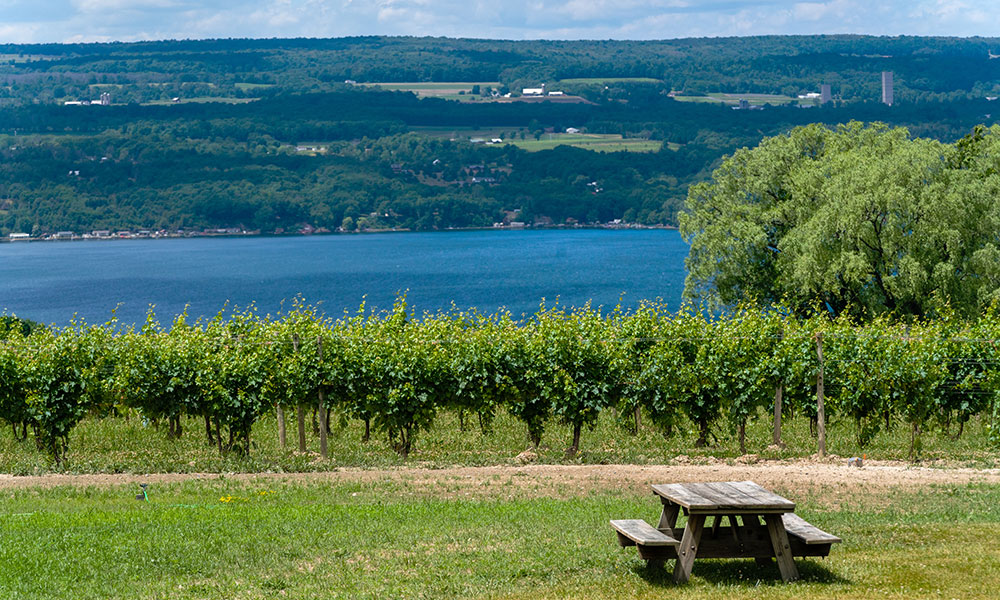Major tourism destination adjusts to limitations placed by global pandemic
By Lou Sorendo
The coronavirus has made a direct hit on the travel and tourism industry, perhaps one of the most vulnerable economic sectors when it comes to dealing with the pandemic.
On its hit list is Finger Lakes Wine Country in Central New York.
While there more than 120 wineries for guests to enjoy in the 12-county Finger Lakes region, savoring enticing beverages is not the only attraction in this scenic Upstate New York destination point.
Attractions range from taking in the charm of idyllic small towns such as Watkins Glen and Hammondsport; watching molten glass be shaped at the Corning Museum of Glass; and enjoying the natural beauty of the Chemung River Valley.
Christina Roberts is vice president of brand development for the Corning-based Finger Lakes Wine Country Tourism Marketing Association, an agency dedicated to enhancing tourism in the region.
She said there is no denying that tourism numbers will be lower than normal.
“However, we’re seeing an uptick in local visitation. This year, we will see more ‘stay-cations’ because people are opting to stay closer to home,” she said.
She addressed the financial impact that COVID-19 has had on the Finger Lakes Wine Country community.
“The loss in tourism-related revenues over the last few months has been substantial and will impact the region moving forward,” she said. “Many businesses in the region not only had a loss in revenue but also incurred expenses to implement new safety regulations.”
Roberts noted the majority of the hospitality industry saw massive lay offs amid the pandemic.
“Many businesses in the region have tapped into government aid to help keep their businesses running,” she noted.
As of late July, the Finger Lakes region was in Phase 4 of reopening non-essential businesses, meaning the region met all metrics required of the state’s regional phased reopening plan. Essential businesses are open, and all non-essential businesses are due to open according to the four phases as outlined by Gov. Andrew Cuomo.
How lucrative is the wine industry in New York state?
A recent study estimates the annual economic impact of the state’s wine industry to be $4.8 billion per year. That includes payroll, taxes, investment and tourism.
According to estimates, travelers spend more than $3 billion in the Finger Lakes region annually while the tourism industry itself supports about 60,000 jobs.
FLWC is home to three wine trails, each offering wine and food pairing events throughout the year. They are the Cayuga, Keuka and Seneca Lake wine trails.
The Cayuga Lake Wine Trail features national and international award-winning wine. The meals, shops, attractions and accommodations make it reportedly one of the best.
Cayuga is the first organized and longest-running wine trail in America. It was established in 1983 to promote wineries located within the Cayuga Lake American Viticultural (cultivation of grapevines) Area as a collective.
Know, obey rules
Roberts said it is important for guests to communicate with accommodations, dining establishments, wineries, and any other businesses they plan to visit during their trip for a clear understanding of what to expect so they can enjoy their time in the region.
“For instance, many wineries are requiring reservations for tasting experiences,” she said.
In New York state, everyone is required to wear a mask in public and maintain at least six feet distance from others to meet social distancing guidelines.
“We appreciate everyone following these guidelines in order to keep the region safe and allowing us to continue to welcome our guests,” Roberts said.
To the chagrin of many wineries in the region, social distancing requirements limit capacity on wine tasting tours and at wine tasting events.
“Restaurants, wineries, breweries and other craft beverage producers have reduced their capacity to 50%,” she said. “Many are managing the capacity by requiring reservations. Others have a hosting station where guests must check in before entering for their tasting experience.”
Over the last several months, the FLWC community has been working hard to lessen the spread of COVID-19.
She said a key to successfully implementing necessary measures is for visitors to respect the guidelines and be prepared for them to be enforced during their time in the area.
Haven for tourists
Roberts said Finger Lakes Wine Country is a rural destination with plenty of open space for visitors to enjoy.
“From hiking trails to kayaking along the many waterways, or even just enjoying a leisurely drive or a lakeside picnic, there are countless ways to enjoy the region while following social distancing guidelines,” she said.
A variety of museums, restaurants, and dozens of other attractions and experiences are open and ready to welcome guests, she added.
“The hospitality and tourism community has maintained close contact over the last few months,” she said. “The support from business to business and organization to organization is encouraging and through collaboration, willingness to be creative, and lots of patience, we will come out on the other side of this stronger than ever.”
As head of marketing, Roberts has had to transform promotional strategies amidst COVID-19.
“We had to completely redevelop our entire marketing plan for 2020,” she said. “We’ve continued to be nimble and creative with how we are marketing the region.”
Traditionally, FLWS focuses the majority of its marketing on a three- tosix hour drive distance from the region.
“But this year, we’ve pulled in our marketing campaigns to be much closer to home,” she said.
So rather than focusing its efforts in Philadelphia, New York City and Toronto, FLWC is focusing on Rochester, Syracuse, and Elmira-Corning.
“We will continue to navigate these uncharted waters carefully because the safety of our region is always our first goal,” she said. “While tourism-related revenue is incredibly important to our livelihood as a region, the health and wellness of our communities is of the utmost importance to us.”
The Finger Lakes region, which features a group of 11 long, narrow, north–south lakes, is New York’s largest wine-producing region. More than 120 wineries and vineyards are around Seneca, Cayuga, Canandaigua, Keuka, Conesus, and Hemlock lakes. Because of the lakes’ great depth, they provide a lake effect to the vineyards along their shores. Retaining residual summer warmth in the winter and winter’s cold in the spring, the grapes are protected from disastrous spring frost during shoot growth, and early frost before the harvest.
The main grape varieties grown are Chardonnay, Riesling, Gewürztraminer, Pinot noir, Cabernet Franc, Vidal blanc, Seyval blanc and many Vitis labrusca (American native) varieties or cultivars.
What is primarily known as a wine region also features craft makers producing cider, beer, and liquor from locally grown and sourced ingredients.
More than one-third of New York’s total breweries are located along the Finger Lakes Beer Trail, contributing to an economic impact of $1.5 billion and support for approximately 9,400 jobs in the region.
All information for all industries in the Finger Lakes region can be found by visiting https://forward.ny.gov/.




